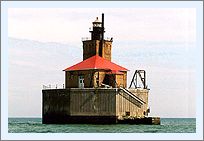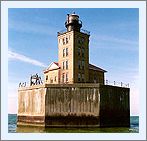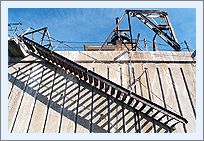|
Historical Information

In 1838, P C Austin arrived in the
area that would eventually receive his name, and established a lumber
mill and dock from which he planned to ship the bounty of the Thumb
area's forests. Although a number of attempts to secure federal funding
for harbor improvements at Port Austin ware undertaken by Michigan's
State Representatives through the 1860's, Port Austin itself would never
attain any great prominence as a shipping point.
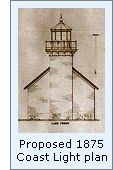 However, by the mid-1870's, the reef
lying 1.7 miles to the northwest off Point Aux Barques had become a
critical obstacle in the path of the growing numbers of mariners
rounding the point in and out of Saginaw Bay. With a but a few small
portions awash, the majority of the craggy reef lurked just below the
surface, waiting to tear the hull of any mariner unfamiliar with the
areas navigation intricacies. Congress appropriated the sum of $10,000
for the construction of a light to mark Port Austin Reef on March 3,
1873, and Eleventh District Engineer Major Godfrey Weitzel dispatched a
survey crew to Port Austin that same year to select a site for the new
light. After two years of unsuccessful negotiations, an alternate site
with a more willing owner some 200 feet eastward was selected in 1875,
and Weitzel drew up plans for a 1½-story brick dwelling with integrated
tower similar to that which would also be built at Sand Point on Lake
Superior in 1878 and at Little Traverse in 1884. The plans were approved
by the Lighthouse Board on September 6, 1875, and construction at Port
Austin scheduled to begin at the opening of navigation the following
year. However, by the mid-1870's, the reef
lying 1.7 miles to the northwest off Point Aux Barques had become a
critical obstacle in the path of the growing numbers of mariners
rounding the point in and out of Saginaw Bay. With a but a few small
portions awash, the majority of the craggy reef lurked just below the
surface, waiting to tear the hull of any mariner unfamiliar with the
areas navigation intricacies. Congress appropriated the sum of $10,000
for the construction of a light to mark Port Austin Reef on March 3,
1873, and Eleventh District Engineer Major Godfrey Weitzel dispatched a
survey crew to Port Austin that same year to select a site for the new
light. After two years of unsuccessful negotiations, an alternate site
with a more willing owner some 200 feet eastward was selected in 1875,
and Weitzel drew up plans for a 1½-story brick dwelling with integrated
tower similar to that which would also be built at Sand Point on Lake
Superior in 1878 and at Little Traverse in 1884. The plans were approved
by the Lighthouse Board on September 6, 1875, and construction at Port
Austin scheduled to begin at the opening of navigation the following
year.
Work was about to commence in the
spring of 1876, when the Lighthouse Board convinced Congress that the
nature of the danger at Port Austin lent itself more appropriately to
the erection of an offshore light to mark the northern extremity of the
reef. Major Weitzel estimated that the revised project could be brought
to completion for an additional $75,000 by locating the keeper's
dwelling onshore on the reservation already purchased, thereby
eliminating the costs of building extensive living quarters on the
offshore crib. Congress made the necessary appropriation on July 31,
1876, and perhaps skeptical of Weitzel's estimate, included the wording
that "the appropriation heretofore made for a light-house at Port
Austin, Michigan, may be expended in commencing the construction of the
proposed light-house on the reef instead of on the shore, provided the
total estimate for its completion shall not exceed eighty-five thousand
dollars."
Construction began in early July 1878
at both Tawas and on the reef off Port Austin. On the reef, a crew
worked to clear and level the selected area in four feet of water at the
northwest end of the reef where the crib would eventually be placed. At
Tawas, where a ready supply of timber could be obtained, work began on
the construction of the crib that would form the core of the offshore
pier itself. A massive octagonal structure, eighty feet in diameter and
six feet in height, the crib form was constructed of twelve-inch square
oak timbers. Assembled on a timber skid-way down which it would
eventually slide into the water, the cribs inner cross members were
secured with three-foot long iron bolts, and the outer timbers secured
to the inner cross members with over 500 iron bolts, each five feet in
length.
 The crib was lowered down the greased
skid-ways into the water, and towed into the open water of Saginaw Bay
in early August. From there, it was carefully towed to Pointe aux
Barques, where an additional four feet of height was added, increasing
the total height of the structure to ten feet. On Sunday August 12,
1877, the completed crib was towed out to the reef, and carefully
centered over the previously cleared and leveled area. A number of doors
in the exterior walls of the crib were opened, allowing water to flow
into sealed pockets within the crib, thereby overcoming the crib's
buoyancy, and lowering it to the prepared rock bottom. The crib was then
secured to the rock bottom with 150 three-inch diameter bolts, seven
feet in length which were sunk through the base of the crib and anchored
with wedges into the rock. Rope caulk and Portland cement were then used
to seal the gaps between the base of the timber crib and the prepared
surface of the rock, and the water within the crib was pumped out. With
the crib now securely anchored to the reef, all eight faces were covered
with a veneer of hard brick to a height of 29 feet. Within these hard
brick walls, fourteen thousand barrels of cement and seven hundred cords
of crushed stone quarried at Grindstone City were poured into the
structure to form the final pier. Work on onshore keeper's dwelling
reached completion in early July 1878, and the crew turned 100% of its
attention to the construction of the tower on the pier. The crib was lowered down the greased
skid-ways into the water, and towed into the open water of Saginaw Bay
in early August. From there, it was carefully towed to Pointe aux
Barques, where an additional four feet of height was added, increasing
the total height of the structure to ten feet. On Sunday August 12,
1877, the completed crib was towed out to the reef, and carefully
centered over the previously cleared and leveled area. A number of doors
in the exterior walls of the crib were opened, allowing water to flow
into sealed pockets within the crib, thereby overcoming the crib's
buoyancy, and lowering it to the prepared rock bottom. The crib was then
secured to the rock bottom with 150 three-inch diameter bolts, seven
feet in length which were sunk through the base of the crib and anchored
with wedges into the rock. Rope caulk and Portland cement were then used
to seal the gaps between the base of the timber crib and the prepared
surface of the rock, and the water within the crib was pumped out. With
the crib now securely anchored to the reef, all eight faces were covered
with a veneer of hard brick to a height of 29 feet. Within these hard
brick walls, fourteen thousand barrels of cement and seven hundred cords
of crushed stone quarried at Grindstone City were poured into the
structure to form the final pier. Work on onshore keeper's dwelling
reached completion in early July 1878, and the crew turned 100% of its
attention to the construction of the tower on the pier.
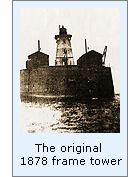 Under normal
circumstances, one would have expected that such an impressive pier
structure would have been topped by an equally impressive tower.
However, forced to work within the limitations of the $85,000
appropriation, the pier was instead capped with a timber-framed tower of
a similar design to that normally used for pierhead beacons. Standing 57
feet in height, the pyramid timber-framed tower was sheathed to contain
rooms below the lantern in which the keepers could store wicks and oil
and take shelter while tending the light. The tower was capped with an
octagonal cast iron lantern outfitted with a clear Fourth Order Fresnel
lens manufactured by Henry Lepaute of Paris. Equipped with red flash
panels, the lens rotated around the lamp by means of a clockwork motor.
The rotation speed of this motor was carefully adjusted and maintained
to place the flash panels in front of the lantern in such a way as to
display the station's characteristic two minute cycle, consisting of a
minute of steady white light, followed by a group of five red flashes
every 12 seconds. Under normal
circumstances, one would have expected that such an impressive pier
structure would have been topped by an equally impressive tower.
However, forced to work within the limitations of the $85,000
appropriation, the pier was instead capped with a timber-framed tower of
a similar design to that normally used for pierhead beacons. Standing 57
feet in height, the pyramid timber-framed tower was sheathed to contain
rooms below the lantern in which the keepers could store wicks and oil
and take shelter while tending the light. The tower was capped with an
octagonal cast iron lantern outfitted with a clear Fourth Order Fresnel
lens manufactured by Henry Lepaute of Paris. Equipped with red flash
panels, the lens rotated around the lamp by means of a clockwork motor.
The rotation speed of this motor was carefully adjusted and maintained
to place the flash panels in front of the lantern in such a way as to
display the station's characteristic two minute cycle, consisting of a
minute of steady white light, followed by a group of five red flashes
every 12 seconds.
Three keepers were selected to man the
station. Charles Kimball, who has served six years as First Assistant at
Pointe aux Barques was promoted to the position of Acting Keeper of the
new station, and Aron Peer was hired to fill the position of his First
Assistant. Evidently Kimball pulled some political strings to get his
brother Alonzo hired as the station's 2nd Assistant, since Alonzo had
previously been removed from lighthouse service in 1886 when he was 1st
Assistant at Pointe aux Barques. Kimball and Peer arrived and moved into
the dwelling on September 9, exhibiting the light from the frame tower
for the first time on the evening of September 15, 1878, and Alonzo
reported for duty on October 18. All told, Weitzel was able to bring the
project to completion for the sum of $81,871, almost $3,000 under
budget.
In 1882, two wood frame buildings were
erected on the crib to house duplicate steam engines which powered twin
fog sirens. Problems with the fog signal's location on the crib some 33
feet above the water quickly surfaced, with the boilers becoming starved
for water due to distance the water had to be raised. To this end, the
valves in the suction pipe were replaced in 1886. However this repair
still proved insufficient, and a high-capacity force pump was added the
following year. Still encountering problems with the water supply, large
wooden reservoir tanks were installed in the signal house in 1888, to
provide a ready supply of water to be drawn by the engines as needed and
replaced by the force pump. Also in this year, the well at the keeper's
dwelling onshore was cleaned out, lined with stone, and outfitted with a
new pump. As part of a general system-wide upgrade, the materials
required for replacing the sirens with 10-inch steam whistles were
delivered at the opening of the 1895 navigation season, with a work crew
arriving at the station early that summer and completing the change-over
on June 30.
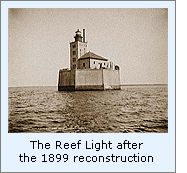 By the end of the nineteenth century,
both the surfaces of the pier and the wood frame tower were showing
signs of the ravages of the weather, and plans were drawn up for a major
upgrade of the structures. In the summer of 1899, a work crew and
materials were delivered at the pier, and by the end of the year, a
resurfacing of the pier was completed, the landing crib on the south
side of the pier was rebuilt and a boat crane and stairway installed.
Thousands of tan bricks from a local brickyard were delivered and the
masons began erecting a new 60-foot tall tower. Standing 16 feet square,
the tower was constructed with double walls, the inner walls being 4
inches in thickness and the outer walls 13 inches thick with a 3-inch
air space between. While the onshore dwelling would continue to serve as
primary living quarters for the keepers, the tower included four floors,
each consisting of a single room with four windows in each providing
views to the south and east. The first floor served as a kitchen and
dining area, and the upper three floors as bedrooms and an office. By the end of the nineteenth century,
both the surfaces of the pier and the wood frame tower were showing
signs of the ravages of the weather, and plans were drawn up for a major
upgrade of the structures. In the summer of 1899, a work crew and
materials were delivered at the pier, and by the end of the year, a
resurfacing of the pier was completed, the landing crib on the south
side of the pier was rebuilt and a boat crane and stairway installed.
Thousands of tan bricks from a local brickyard were delivered and the
masons began erecting a new 60-foot tall tower. Standing 16 feet square,
the tower was constructed with double walls, the inner walls being 4
inches in thickness and the outer walls 13 inches thick with a 3-inch
air space between. While the onshore dwelling would continue to serve as
primary living quarters for the keepers, the tower included four floors,
each consisting of a single room with four windows in each providing
views to the south and east. The first floor served as a kitchen and
dining area, and the upper three floors as bedrooms and an office.
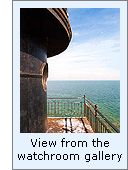 The tower was capped with a square cast
iron gallery with hand railing, centered on which a circular cast iron
watch room was erected. This watchroom was lined with oak bead board and
featured four brass portholes offering a view of the lake in each
direction, and supported a circular gallery and cast iron lantern. With
an inner diameter of almost 8 feet, as was the case with almost all
lanterns installed at this time, the curved lantern glass was set in
thin diagonal astragals to provide a virtually uninterrupted focal plane
for the lens. At the end of the 1899 navigation season, the lens from
the frame tower was disassembled and reinstalled atop the new tower from
whence it was exhibited for the first time of the opening of the 1900
season of navigation. In its new location, the lens sat at a focal plane
of 76 feet, with a resulting range of visibility of 16 ½ miles.
Integrated into the southwest corner of the tower, a 34 foot square
hip-roofed fog signal building was constructed of similar brick and
construction, and both steam boilers placed onto elevated pads at the
building's center. The tower was capped with a square cast
iron gallery with hand railing, centered on which a circular cast iron
watch room was erected. This watchroom was lined with oak bead board and
featured four brass portholes offering a view of the lake in each
direction, and supported a circular gallery and cast iron lantern. With
an inner diameter of almost 8 feet, as was the case with almost all
lanterns installed at this time, the curved lantern glass was set in
thin diagonal astragals to provide a virtually uninterrupted focal plane
for the lens. At the end of the 1899 navigation season, the lens from
the frame tower was disassembled and reinstalled atop the new tower from
whence it was exhibited for the first time of the opening of the 1900
season of navigation. In its new location, the lens sat at a focal plane
of 76 feet, with a resulting range of visibility of 16 ½ miles.
Integrated into the southwest corner of the tower, a 34 foot square
hip-roofed fog signal building was constructed of similar brick and
construction, and both steam boilers placed onto elevated pads at the
building's center.
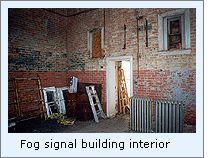 In 1902, the landing pier and boat
house at the dwelling were completely rebuilt. The stairway leading from
the boathouse up the bank to the dwelling was also renewed, as were the
concrete sidewalks around the dwelling. In 1915, the lamp was upgraded
to an incandescent oil vapor (IOV) unit, increasing the output to 4,000
candlepower. At this same time, the characteristic of the light was also
changed to a repeated 12 second cycle consisting of red flashes of 1.4
seconds in duration followed by 10. 6 second eclipses. In 1902, the landing pier and boat
house at the dwelling were completely rebuilt. The stairway leading from
the boathouse up the bank to the dwelling was also renewed, as were the
concrete sidewalks around the dwelling. In 1915, the lamp was upgraded
to an incandescent oil vapor (IOV) unit, increasing the output to 4,000
candlepower. At this same time, the characteristic of the light was also
changed to a repeated 12 second cycle consisting of red flashes of 1.4
seconds in duration followed by 10. 6 second eclipses.
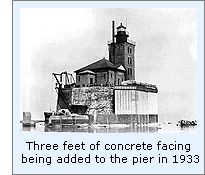 With recent advances in fog signal
technology, a work crew again returned to the pier in 1933 to replace
the 38 year old 10-inch steam whistles with a pair of compressed air
operated "Type F" diaphones. Operated by diesel-powered air
compressors, these new diaphones represented a significant advantage
over the steam-powered whistles in that they could be operating within
minutes of discovering that visibility was decreasing, whereas the old
steam units took up to an hour to build sufficient steam before they
could be sounded. To provide a mounting location for the trumpet-like
resonators which projected the sound of the diaphone across the water, a
gable was added to the roof of the signal building. With this new
installation, the fog signal characteristic was also changed to a
repeated one minute cycle consisting of a first blast of 3 seconds
followed by a silent interval of 3 seconds, a second blast of 3 seconds
followed by 51 seconds of silence. Finally, the work crew added three
feet of concrete facing to all eight sides of the pier to protect its
weathering surface. With recent advances in fog signal
technology, a work crew again returned to the pier in 1933 to replace
the 38 year old 10-inch steam whistles with a pair of compressed air
operated "Type F" diaphones. Operated by diesel-powered air
compressors, these new diaphones represented a significant advantage
over the steam-powered whistles in that they could be operating within
minutes of discovering that visibility was decreasing, whereas the old
steam units took up to an hour to build sufficient steam before they
could be sounded. To provide a mounting location for the trumpet-like
resonators which projected the sound of the diaphone across the water, a
gable was added to the roof of the signal building. With this new
installation, the fog signal characteristic was also changed to a
repeated one minute cycle consisting of a first blast of 3 seconds
followed by a silent interval of 3 seconds, a second blast of 3 seconds
followed by 51 seconds of silence. Finally, the work crew added three
feet of concrete facing to all eight sides of the pier to protect its
weathering surface.
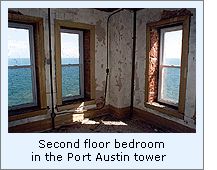 1937 saw the addition of
three feet of
concrete to all sides of the pier, faced with steel plates from the rock
bottom to approximately six feet above the water line to protect the
concrete from the grinding action of the ice. With the transfer of
responsibility of the nation's aids to navigation to the Coast Guard in
1939, a submarine electric cable was run from the shore out to the pier,
allowing the installation of electric lighting in the fog signal and
tower, and the replacement of the IOV lamp in the lantern with a 25,000
candlepower incandescent electric bulb, without any change in the
light's characteristic. The Fresnel lens was removed from the lantern
three years later, to be replaced by a 300 mm glass lens, and the
characteristic again changed to a repeated one second flash followed by
a 9 second eclipse. The light was completely automated in 1953,
eliminating the need for full time keepers at the station. No longer
serving any purpose, the onshore dwelling was sold into private
ownership at some time thereafter. 1937 saw the addition of
three feet of
concrete to all sides of the pier, faced with steel plates from the rock
bottom to approximately six feet above the water line to protect the
concrete from the grinding action of the ice. With the transfer of
responsibility of the nation's aids to navigation to the Coast Guard in
1939, a submarine electric cable was run from the shore out to the pier,
allowing the installation of electric lighting in the fog signal and
tower, and the replacement of the IOV lamp in the lantern with a 25,000
candlepower incandescent electric bulb, without any change in the
light's characteristic. The Fresnel lens was removed from the lantern
three years later, to be replaced by a 300 mm glass lens, and the
characteristic again changed to a repeated one second flash followed by
a 9 second eclipse. The light was completely automated in 1953,
eliminating the need for full time keepers at the station. No longer
serving any purpose, the onshore dwelling was sold into private
ownership at some time thereafter.
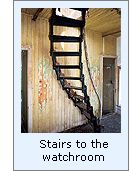 The 300 mm glass lens was removed in
1985, and replaced by a 12-volt solar powered Tidelands Signal 300 mm
acrylic optic, eliminating the need for ongoing maintenance of the
submarine cable. Without the constant care of full-time keepers, the
structure began to deteriorate, with the fog signal building roof
caving-in, allowing the weather and thousands of birds to wreak havoc on
the building's interior. To exacerbate the problem, vandals had broken
out most of the windows and doors, and stolen anything that could be
removed from the structure. Without the necessary manpower and funds to
make necessary repairs, the Coast Guard formulated plans to demolish the
buildings and replace them with a low-maintenance skeletal metal tower
to house the solar-powered light. The 300 mm glass lens was removed in
1985, and replaced by a 12-volt solar powered Tidelands Signal 300 mm
acrylic optic, eliminating the need for ongoing maintenance of the
submarine cable. Without the constant care of full-time keepers, the
structure began to deteriorate, with the fog signal building roof
caving-in, allowing the weather and thousands of birds to wreak havoc on
the building's interior. To exacerbate the problem, vandals had broken
out most of the windows and doors, and stolen anything that could be
removed from the structure. Without the necessary manpower and funds to
make necessary repairs, the Coast Guard formulated plans to demolish the
buildings and replace them with a low-maintenance skeletal metal tower
to house the solar-powered light.
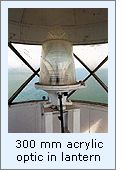 On learning of the plans to demolish
the station, Port Austin businessman Louis Shillinger gathered together
with a number of acquaintances to form the Port Austin Reef Light
Association. A non profit corporation chartered to restore and maintain
the station, PARLA obtained a five year license from the Coast Guard in
1988, and set about the daunting task of stabilizing the deteriorating
structure. Over the following two years, the decaying roof on the fog
signal building was completely removed and new trusses and decking were
installed. The decking was then covered with galvanized metal shingles,
and painted a historically accurate bright red. A railing was added to
the access ladder, the safety chains around the edge of the deck were
replaced, a new brick chimney was installed, and 18 windows were removed
and replaced. In 1990, PARLA's license to renovate the structure was
extended an additional thirty years through 2020. On learning of the plans to demolish
the station, Port Austin businessman Louis Shillinger gathered together
with a number of acquaintances to form the Port Austin Reef Light
Association. A non profit corporation chartered to restore and maintain
the station, PARLA obtained a five year license from the Coast Guard in
1988, and set about the daunting task of stabilizing the deteriorating
structure. Over the following two years, the decaying roof on the fog
signal building was completely removed and new trusses and decking were
installed. The decking was then covered with galvanized metal shingles,
and painted a historically accurate bright red. A railing was added to
the access ladder, the safety chains around the edge of the deck were
replaced, a new brick chimney was installed, and 18 windows were removed
and replaced. In 1990, PARLA's license to renovate the structure was
extended an additional thirty years through 2020.
Since that time, exterior doors have
been replaced, bricks have been tuck pointed, and various painting and
maintenance tasks have been undertaken. PARLA has plans to completely
restore the interior of the station, and welcomes anyone who is
interested in donating their time, money or materials to the project of
helping return the station to its original utilitarian glory.

Keepers of
this Light

Click here
to see a complete listing of all Port Austin Reef Light keepers compiled
by Phyllis L. Tag of Great Lakes Lighthouse Research.

Seeing this light

A couple of members of PARLA kindly agreed to show
us around the station in September 2002. After meeting for breakfast on
a fine, sunny September morning, we boarded the thirty foot pontoon boat
which serves as PARLA's working platform for the ten minute trip out to
the light. As we approached the light, we could see that cormorants were
sitting on the cranes and railings, and after making our way to the deck
level we could see first-hand the damage done buy these birds. We
learned that while the birds still leave their "greeting
cards" all over the structure, it pales in comparison to what the
PARLA folks found when they first went out to the station in 1988. As a
result of the huge holes in the roof and the missing windows, their
first task was to remove over a foot of bird and bat droppings from
every floor in the structure, carting the messy residue to shore for
proper disposal.
We spent a pleasant and
very informative two and a half hours exploring every nook and cranny of
the station, before making the trip back to shore, and heading south to
revisit the Pointe aux Barques Light.

Finding this
Light

Since public tours are of the light are not currently available, a
distant view of the station may be obtained from the docks of the public
marina located in downtown Port Austin. Close-up view of the lighthouse
can be obtained by private or chartered boat, and there are excellent
launch facilities at the public dock. However, extreme caution must be
taken when approaching the light due to the shallow water that covers
the rocks on which the light is located in all directions. There are
also a number of charter boat captains operating out of Port Austin with
whom it is likely that a trip out to view the light from the water could
be arranged for a reasonable fee.

Contact Information

Port Austin Reed Light Association
P.O. Box 546
Port Austin, MI 48467

Reference
Sources

 Journal of the US Senate, 1867 Journal of the US Senate, 1867
Congressional Journal, 1868, 1873
Detroit Free Press, August 1877
Scott's New Coast Pilot, 1888
Annual reports of the Lighthouse Board,
1874 through 1909
Annual reports of the Lighthouse Service, 1910 through 1939
Great Lakes Light Lists, 1901, 1928, 1939, 1958
Great Lakes Pilot,
2000, NOAA
Northern Lights, Charles K. Hyde, 1995
Pamphlet produced by
PARLA for 1999 lighthouse centennial
Discussion with Lou Shillinger
during 09/14/02 visit to Port Austin.
Keeper listings for this light appear courtesy of Great
Lakes Lighthouse Research
|
